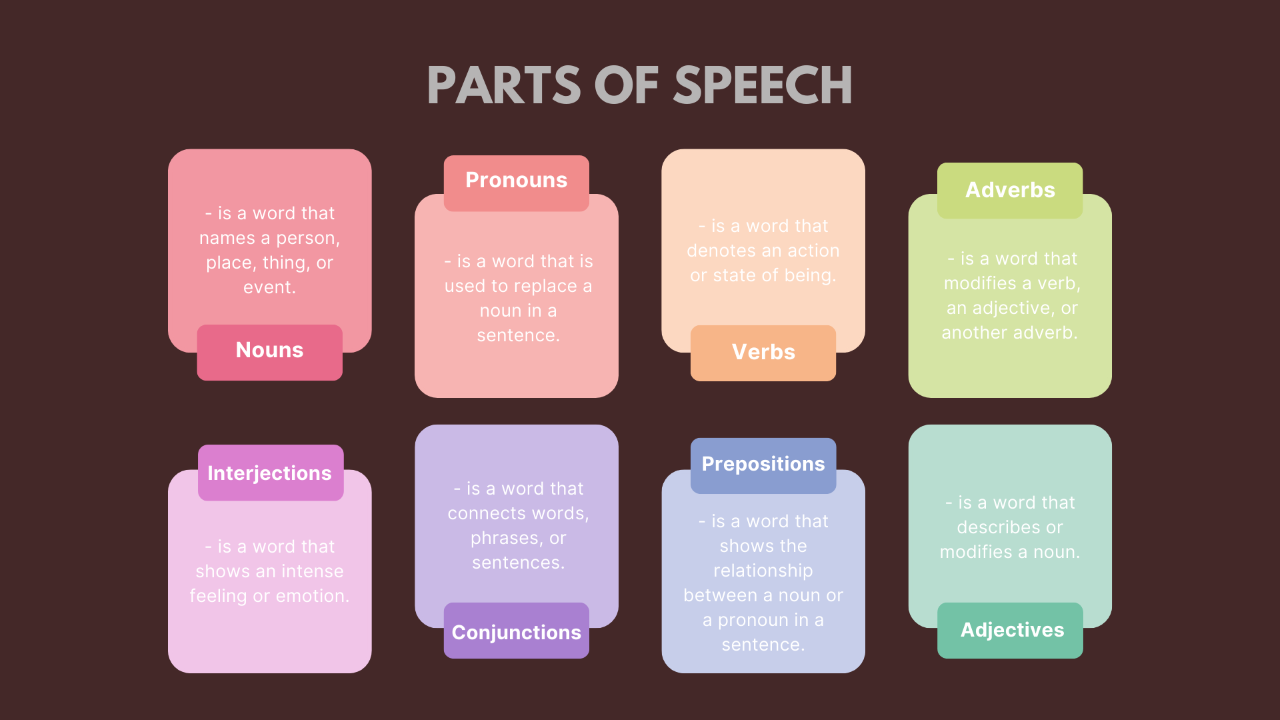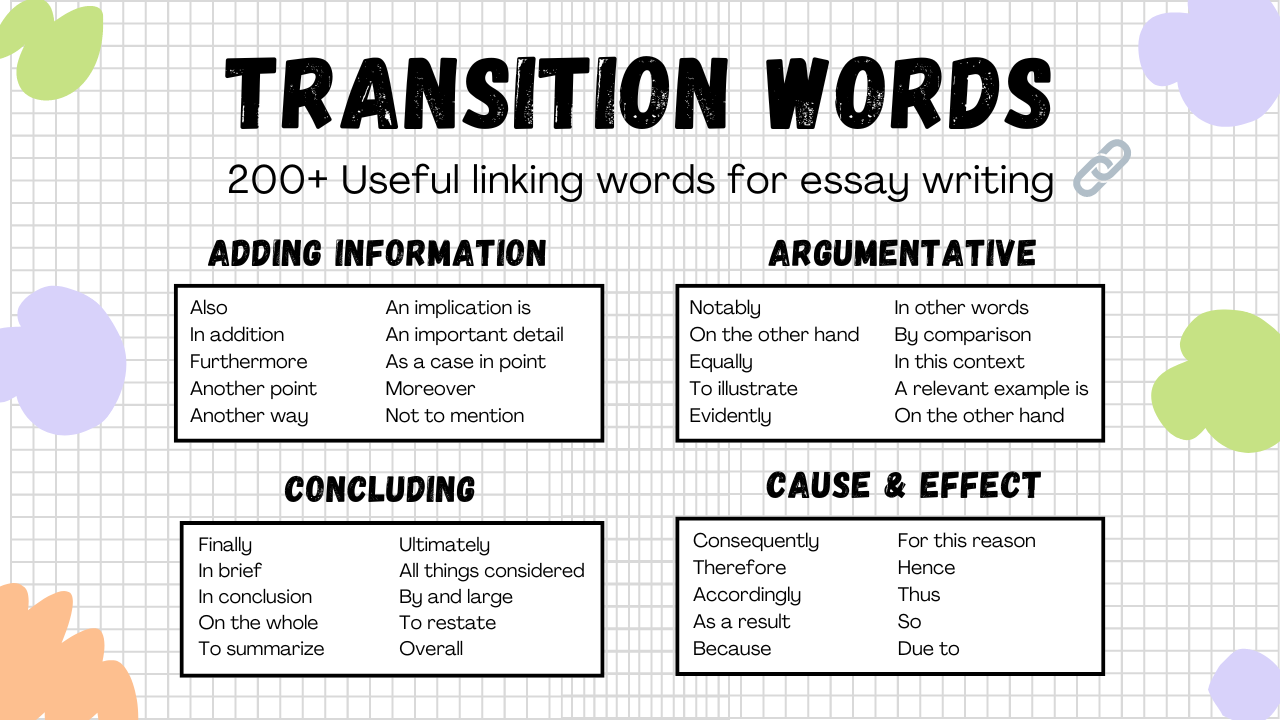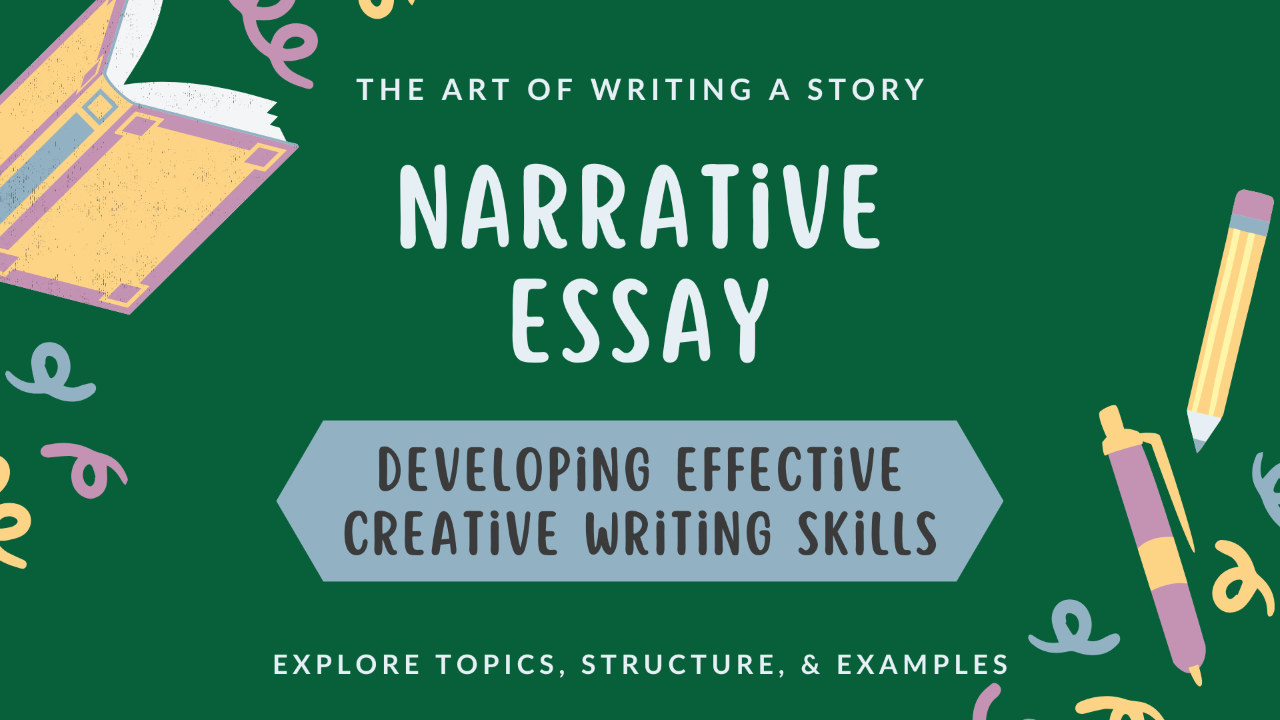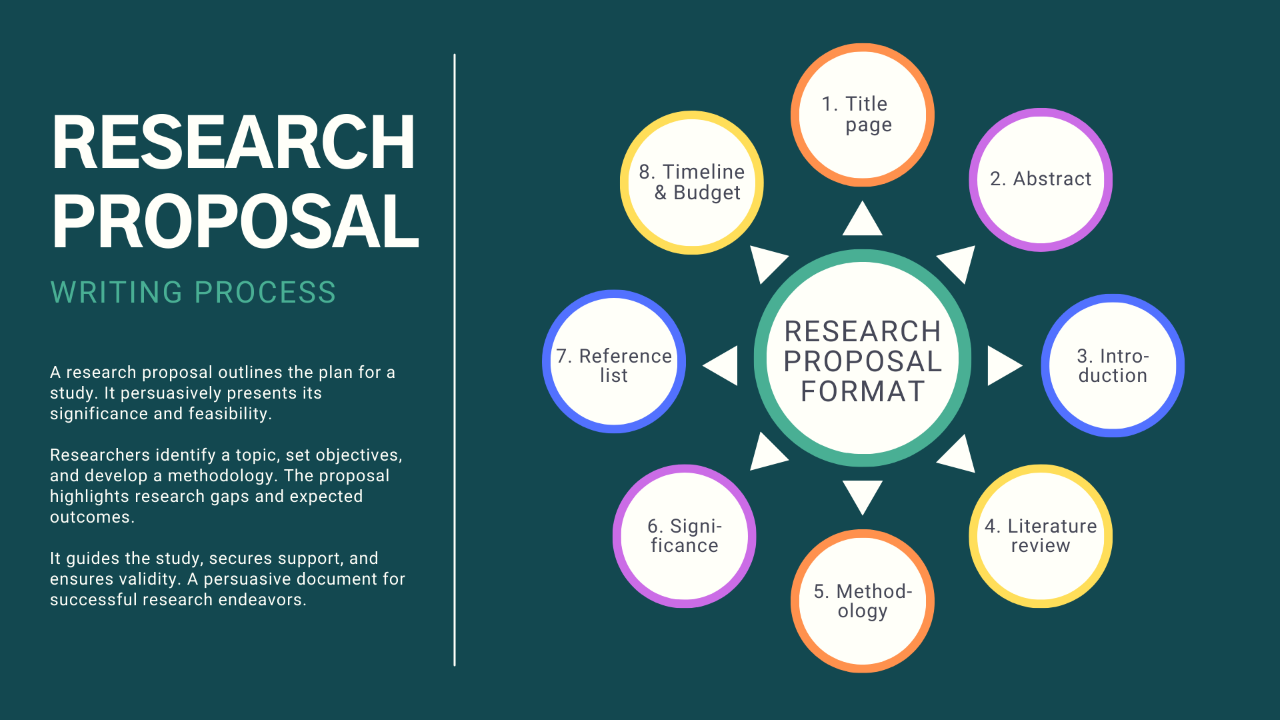
Parts of Speech: Understanding the Building Blocks of Language
In the vast landscape of the English language, words serve distinct purposes. Some express action, others describe things, and some join words together. These words, known as parts of speech. They come together like the parts of a house, each playing a crucial role in constructing a well-formed sentence. Imagine the parts of speech as the building blocks that lay the foundation, form the walls, frame the windows and doors, and ultimately unify the elements of language. Among the eight essential parts of speech - verbs, nouns, adjectives, adverbs, pronouns, prepositions, conjunctions, and interjections - each has a unique function in building the structure of effective communication. Let's explore the intricacies of these linguistic components including other parts of speech such as determiners and discover how they shape our sentences and the overall language landscape.
1 Nouns: Naming the Objects
Nouns, those versatile components of speech, form the very foundation of language itself. They serve as the essential building blocks that enable us to name and identify the diverse elements of our world, encompassing a vast array of entities ranging from tangible objects to intangible concepts. By categorizing nouns into two distinct groups—common nouns and proper nouns—we establish a vital distinction in their usage. Common nouns, with their broad scope, encompass general items that can be applied universally, while proper nouns, with their specific nature, denote unique names and individual identities. Gaining a deep understanding of this fundamental contrast empowers us to engage in clear and accurate communication, ensuring that our messages resonate with precision and meaning. Here are few example sentences for both common and proper nouns.
Example: Common Nouns
The team worked together to win the championship.
The car raced down the street, leaving a trail of dust behind.
The common nouns "team" and "car" represent general objects that can be applied to any similar instance. They do not refer to any specific team or car.
Example: Proper Nouns
Colchester United is a professional football club based in England.
Nicole greeted her friends with a warm smile.
The proper nouns "Colchester United" and "Nicole" represent specific names. "Colchester United" refers to a particular football club, while "Nicole" refers to an individual person. These proper nouns are unique and distinguishable from others, indicating specificity.
By utilizing common and proper nouns appropriately, we can convey precise information and effectively communicate with others, ensuring clarity and understanding in our language usage.
2 Pronouns: Streamlining Language with Efficient Referencing
Pronouns, those nimble linguistic tools, streamline our sentences by replacing nouns. They serve as efficient substitutes for specific individuals, objects, or ideas, ensuring that our language remains concise and avoids unnecessary repetition. Pronouns play a crucial role in maintaining sentence flow and clarity, while preserving the intended meaning of our messages.
Consider the following examples that showcase the use of pronouns:
Example: Pronouns
Mary loves to play the guitar. She practices every day to improve her skills.
The book on the table is mine. It has been in my possession for years.
Tom and Sarah are going to the cinema. They have already bought their tickets.
In the first sentence, the pronoun "she" replaces the noun "Mary," allowing us to refer back to the subject without repetition. Similarly, in the second sentence, the pronoun "it" substitutes the noun phrase "the book on the table," facilitating a more concise expression of ownership. In the last sentence, the pronoun "they" takes the place of the noun phrase "Tom and Sarah," ensuring a smoother flow of the sentence.
By utilizing pronouns effectively, we enhance the efficiency and clarity of our language, facilitating smooth communication while maintaining the intended meaning of our sentences.
3 Verbs: Dynamic Expressions of Action and Being
Verbs are the powerhouse of a sentence, portraying actions and states of being. They can be identified as "doing words" and play a vital role in describing what nouns are doing in a sentence. For instance, words like swimming, sleeping, writing, and learning all function as verbs. By grasping the importance of verbs, you can effectively convey actions and express thoughts with precision.
Example: Verbs
The children eagerly ran towards the playground, their laughter filling the air.
The sun shines brightly, casting a warm glow over the picturesque landscape.
In the first example, the verb "ran" conveys the action of the children moving swiftly towards the playground. It paints a vibrant picture of their excitement and energy. While in the second example, the verb "shines" describes the ongoing state of the sun radiating light and warmth. It portrays a continuous action or condition.
By using verbs effectively, we can bring life and vitality to our sentences, engaging readers and conveying our intended meanings with clarity.
4 Adjectives: Bringing Life and Color to Nouns
Adjectives, those descriptive powerhouses, bring life and color to our nouns. These words have the remarkable ability to infuse our nouns with specific qualities that make them more vivid and precise. They act as the paintbrushes of language, adding vibrant details to our sentences and making our descriptions more engaging. Let's explore a few examples that highlight the transformative power of adjectives:
Example: Adjectives
The sun dipped below the horizon, casting a magnificent golden glow across the landscape.
Her voice echoed through the hall, its melodious tones captivating the audience.
The forest path led to a secluded clearing, where rays of sunlight filtered through the dense foliage.
In the first example, the word "magnificent" intensifies the noun "golden glow," creating a vivid image of a breathtaking spectacle. In the second example, the word "melodious" enhances the noun "voice," evoking the enchanting sound of captivating music. Lastly, the word "secluded" adds depth to the noun "clearing," suggesting a quiet and hidden space.
By using adjectives, we can bring our sentences to life, making them more vibrant and engaging. These words allow us to paint a clearer picture in the minds of our readers, enabling them to fully immerse themselves in our descriptions.
5 Adverbs: Enhancing the Action
Adverbs, the unsung heroes of language, are masters at modifying verbs. Unlike adjectives, which bring life to nouns, adverbs add a layer of detail to verbs, shedding light on how an action is performed. These versatile words provide information about manner, time, place, or degree, allowing us to express ourselves with greater precision. Let's look into a few examples that showcase the power of adverbs in enhancing our descriptions:
Example: Adverbs
She ran quickly through the bustling city streets, dodging pedestrians and darting between cars.
The old man spoke softly, his words barely audible above the rustling leaves and chirping birds.
The students diligently worked on their assignments, meticulously researching and crafting their essays.
In the first example, the adverb "quickly" modifies the verb "ran," giving us a sense of the speed and agility with which she navigated the busy streets. In the second example, the adverb "softly" adds a layer of subtlety to the verb "spoke," suggesting a gentle and hushed tone. Lastly, the adverb "diligently" paints a picture of the students' meticulous efforts, emphasizing their thoroughness in working on their assignments.
By incorporating adverbs, we can enrich our descriptions and provide a more comprehensive portrayal of actions. These words allow us to express the nuances of how something is done, adding depth and precision to our writing. So, the next time you want to enhance your verbs and capture the essence of an action, remember the power of adverbs and let them transform your sentences into vibrant and engaging expressions.
6 Prepositions: Describing Position and Movement
Prepositions, the navigators of language, hold the key to describing the position and movement of nouns within a sentence. These small but mighty words, such as "to," "from," "into," "out," "of," "at," "for," and "in," play a crucial role in clarifying the relationships between objects and their location. By using prepositions, you gain the ability to convey spatial and directional information with precision. Let's explore a few examples that demonstrate the importance of prepositions in guiding our sentences:
Example: Prepositions
She walked to the park, enjoying the crisp autumn breeze.
The book fell from the shelf, landing with a loud thud on the floor.
The children jumped into the pool, splashing and laughing with delight.
In the first example, the preposition "to" indicates the direction of the subject's movement towards the park. It helps us understand the destination and sets the stage for the scene. In the second example, the preposition "from" describes the origin of the book's fall, highlighting the starting point of its descent. Finally, in the third example, the preposition "into" reveals the action of the children immersing themselves in the pool, bringing to life their playful and joyous experience.
Prepositions serve as the guides that navigate us through the spatial and directional aspects of our language. They bring clarity and precision to our descriptions, allowing readers to visualize the relationships between objects and their surroundings. By understanding prepositions and their usage, you unlock the ability to paint vivid pictures with your words and guide your readers on a journey through your sentences.
7 Conjunctions: The Connectors of Ideas and Thoughts
Conjunctions, the skilled connectors in the vast landscape of language, play a crucial role in linking ideas, thoughts, and clauses. These small but mighty words, such as "and," "but," "or," "so," and "yet," serve as bridges that seamlessly join different parts of a sentence. They bring coherence and flow to our writing, allowing us to express complex relationships between words, phrases, and clauses. Let's explore the different types of conjunctions and their respective functions:
Coordinating Conjunctions:
Coordinating conjunctions, such as "and," "but," and "or," join words, phrases, or independent clauses of equal importance. They allow us to connect similar or contrasting ideas, choices, or options. For example:
Example: Coordinating Conjunctions
I like to read books, and my sister prefers watching movies.
He wanted to go for a walk, but it started raining.
You can choose either the blue shirt or the red one.
Subordinating Conjunctions:
Subordinating conjunctions, such as "because," "although," and "while," establish a relationship of dependence between the main clause and the subordinate clause. They introduce dependent clauses that cannot stand alone as complete sentences. For example:
Example: Subordinating Conjunctions
She succeeded because she worked hard.
Although it was cold outside, they went for a picnic.
While I was studying, my phone rang.
Correlative Conjunctions:
Correlative conjunctions work in pairs to connect balanced and parallel structures within a sentence. Examples of correlative conjunctions include "either...or," "neither...nor," and "both...and," For example:
Example: Correlative Conjunctions
Either you study for the test, or you risk failing it.
Neither the rain nor the storm could dampen their spirits.
Both the parents and the teachers praised the students' efforts.
Conjunctions act as powerful tools for cohesion and coherence in our writing. They allow us to express relationships, contrasts, conditions, reasons, and more, facilitating the smooth flow of ideas and thoughts.
8 Interjections: Expressing Emotions and Reactions
Interjections, the lively expressions of our emotions and reactions, add a touch of spontaneity and flair to our language. These short and impactful words, such as "wow," "oh," "hurray," "ouch," and "alas," serve as linguistic bursts that convey our immediate feelings or responses. Let's explore the different types of interjections and how they contribute to the richness of our expressions:
Exclamatory Interjections:
Exclamatory interjections are used to convey strong emotions such as surprise, excitement, joy, or pain. They often stand alone and are followed by an exclamation mark.
Example: Exclamatory Interjections
Wow! What a beautiful sunset!
Ouch! That was a painful fall!
Alas! She missed her flight.
Greeting Interjections:
Greeting interjections are used to greet or acknowledge someone. They are expressions of salutations, goodwill, or recognition. For example:
Example: Greeting Interjections
Hello! How are you today?
Hey! Long time no see!
Hi! Nice to meet you!
Interjections of Agreement or Approval:
Interjections of agreement or approval are used to show support, consent, or agreement with someone's statement or action. For example:
Example: Interjections of Agreement or Approval
Yes! That's exactly what I was thinking.
Absolutely! I couldn't agree more.
Bravo! Well done on your performance.
Interjections of Disapproval or Surprise:
Interjections of disapproval or surprise are used to express disbelief, shock, or disagreement with something. For example:
Example: Interjections of Disapproval or Surprise
Oh no! I can't believe that happened.
Ugh! This food tastes terrible.
Whoa! That's an incredible story.
Interjections add an extra layer of emotion and spontaneity to our language. They allow us to express our immediate reactions and sentiments without the need for lengthy explanations. By incorporating interjections appropriately, we can inject our writing and conversations with energy, authenticity, and a touch of our unique personality.
Determiners: The Precise Pointers in Language
Determiners play a crucial role in the world of language, serving as precise pointers that introduce and specify nouns. These small but significant words provide essential information about the quantity, ownership, definiteness, and identification of the noun they modify. Whether it's indicating whether something is specific or general, expressing possession, or quantifying the noun, determiners bring clarity and specificity to our writing. By understanding and using determiners effectively, you can ensure that your readers grasp the exact context and details you intend to convey. Let's look into a few examples that demonstrate the significance of determiners in our sentences:
Example: Determiners
The dog chased the squirrel up the tree.
My sister owns a beautiful house in the countryside.
Each student must bring their own pen to the exam.
In the first example, the definite article "the" specifies that it is a particular dog that is chasing the squirrel, not just any dog. It adds a sense of specificity to the sentence. In the second example, the possessive determiner "my" signifies that the house belongs to the speaker's sister, indicating ownership. It establishes a personal connection. In the third example, the indefinite determiner "each" emphasizes that every individual student is required to bring their own pen, highlighting the individuality and responsibility of each student.
Determiners serve as valuable tools in shaping the meaning and scope of our sentences. They help us express definiteness, possession, quantity, and more, ensuring that our communication is clear, precise, and tailored to the intended context.
The eight parts of speech serve as the essential building blocks that give structure and meaning to our language. Like the different components of a house, each part of speech fulfills a specific role in constructing well-formed sentences. They work harmoniously, forming the foundation, walls, windows, and doors of our linguistic expressions. As we explore these linguistic components, we realize their profound impact on shaping our sentences and the overall language landscape. It is through the mastery of verbs, nouns, adjectives, adverbs, pronouns, prepositions, conjunctions, interjections, and even determiners that we understand the true potential of effective communication.
'
Free Sample Essays & Papers
Download free PDF examples of essays and papers in various subjects, all with different citation styles! Get inspired, conquer writer's block, and find the perfect format for your next assignment. Click to download now!




